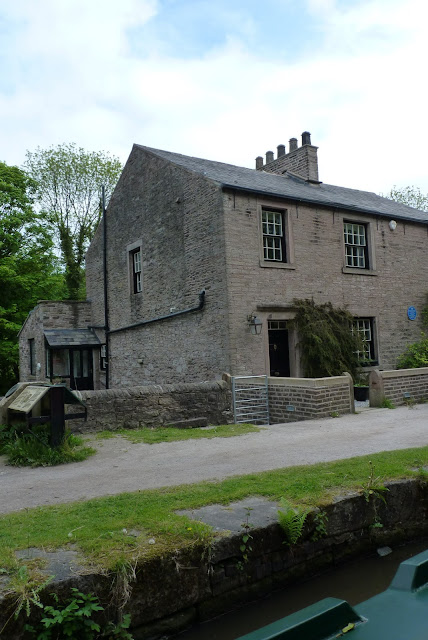We paid a visit to Tesco's that was pretty close to our moorings and bagged a bargain on cat food. We could buy big as it wasn't too far too carry it. We soon got it stowed and we set off on the short trip round to Bugsworth Basin. This was an industrial complex that was abandoned in about 1927 and the buildings taken down to use the stone.
The Upper Basin dealt with gritstone exports as well as lime and limesotne. This had been discovered in the seams of the quarry and was found to be good for building and for paving. Thousands of tonnes of it were transported to Manchester to pave the streets as setts or slabs. There was a crane to load the boats
Wharfingers house.
Near the entrance to the basins as a restriction in the canal. This is opposite the Wharfingers house and where the boats would be check for their load by guaging the draft etc. This, and the distance to take the cargo, would decide the tolls paid. A little further on the canal widens out into three arms. Straight on takes you up the Lower Basin. To get to the other basins bridges were built over them to enable the horses to continue to pull them along.
Horse Bridges across the Lower Basin and Lower Basin Arm.
The lower Basin had a stone crusher on one side and a wagon tippler on the other. The stone was limestone from Dove Holes Quarry, the same quarry as provide the limestone to Froghall. It was brought down using has drawn tram ways. On this arm the stone was crushed and and loaded into the boats, or just as it came from the quarry. The trackways were elevated on wooden legs so that the stone could be tipped down. The stone was sent away to other places and also used for 50 years as ballast for the railways.
Lower Basin looking west. The heavy foundations by the first boat is the site of the stone crusher.
The limestone was also used to load up lime kilns. The limestone was alternated with a layer of coal and fired in the kiln. The product would be quicklime. The smoke and heat must have been awful. The temperature had to be between 900 and 1100C. Not only would the heat be bad but the quicklime was acidic and all they had was leather gloves. The workers had to dig the kiln out once the process had completed and either load it directly into narrow boats or into Lime Sheds. The quick lime was transported and could then be used for a variety of things. It was slacked before use by adding water. It therefore had to be kept dry so as not to slack it accidentally.
The Peninsula with the Middle Basin on the left and the lower Basin on the right. The tramway tracks can be seen here leading to the stone crusher and the Lower Basin Arm.
The Lower Basin Arm was used for more general goods coming in and out. The tramway supported mills all the way along it such as cotton and woolen mills dye manufacturers etc, and they need goods and equipment supplied too. Farms in the area also used the tramways and canals too. There was a warehouse built over the arm, for security and protection.
The Middle Basin had a bank of lime kilns on the south side at Silk Hill called Gnat Hole Kilns. Below the lime kilns were the lime sheds to store the product. The Middle Basin arm serviced the kilns on the north side where the lime was barrowed over the stream and into a lime shed that covered the end of the arm so the boats could be loaded under cover.
Middle Basin showing the remains of Gnat Hole Lime Kilns on the right, the bridge through to the Upper Basin and the tunnel to the left to the Middle Basin Arm. The small tunnel is for access around the site. The level above the bridges is the tramways to the various places. In the distance the stone building is the Navigation Inn.
The Upper Basin dealt with gritstone exports as well as lime and limesotne. This had been discovered in the seams of the quarry and was found to be good for building and for paving. Thousands of tonnes of it were transported to Manchester to pave the streets as setts or slabs. There was a crane to load the boats
Bridge through from the Middle Basin to the Upper Basin.
At it's peak there were 80 narrow boats a day leaving here loaded. There were often over 2000 a year. Mind you there is a notice warning that it is first come, first served these days in the Basins. It is only 48 hours stay in busy times and they warn at the height of the summer holidays and Bank Holidays there can be 60 arrive in a day. The place must have been very different from to day as, despite the proximity of the A6 it is very peaceful, and I don't suppose the Basin supported populations of water voles as the water must have been very polluted with all the lime etc. With luck I will get some more shots tomorrow to bore you with.
Oh yes I nearly forgot I managed to change the gear box and engine oil and the oil filter. It will be easier next time now I know the wrinkles. Helen also baked a Carrot cake!






No comments:
Post a Comment